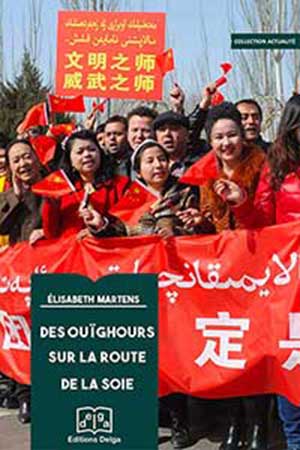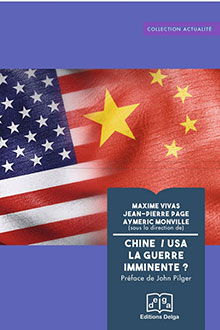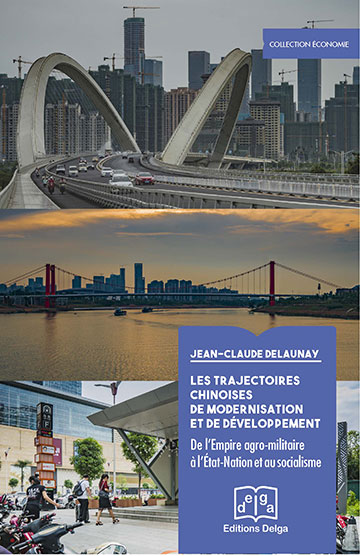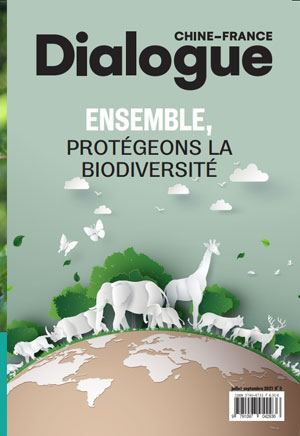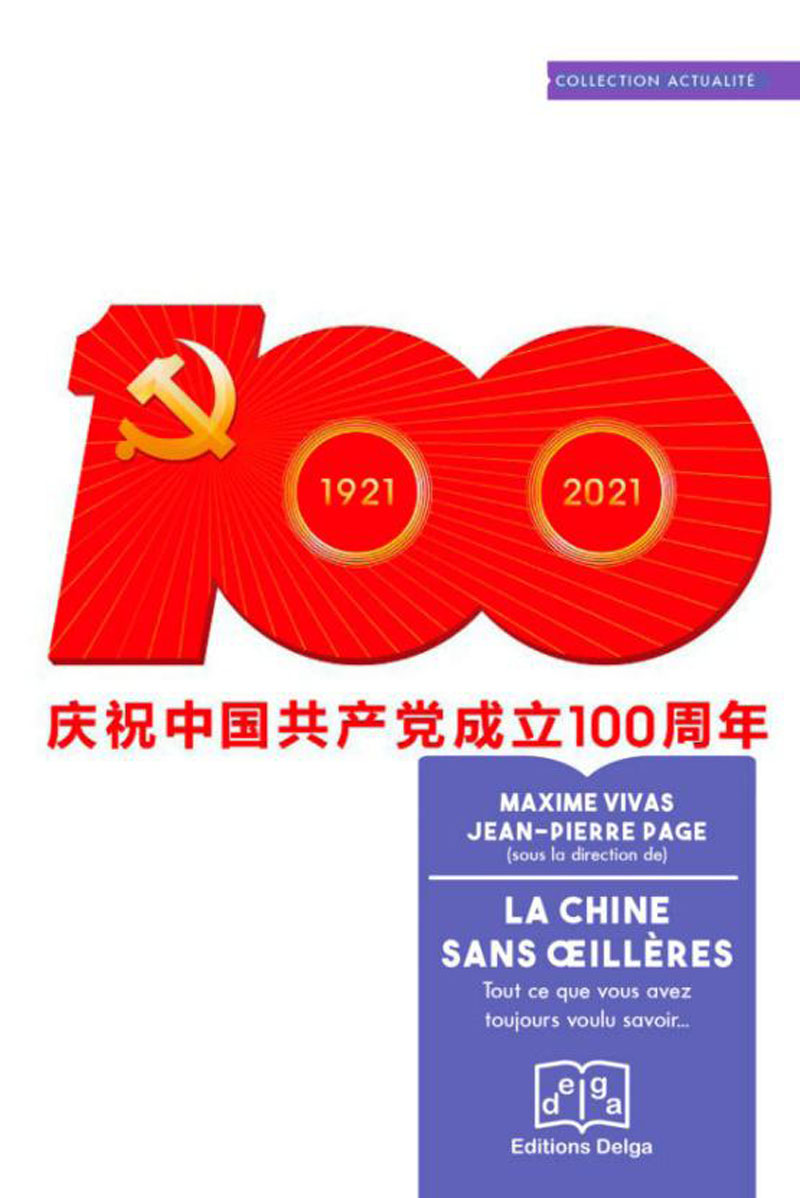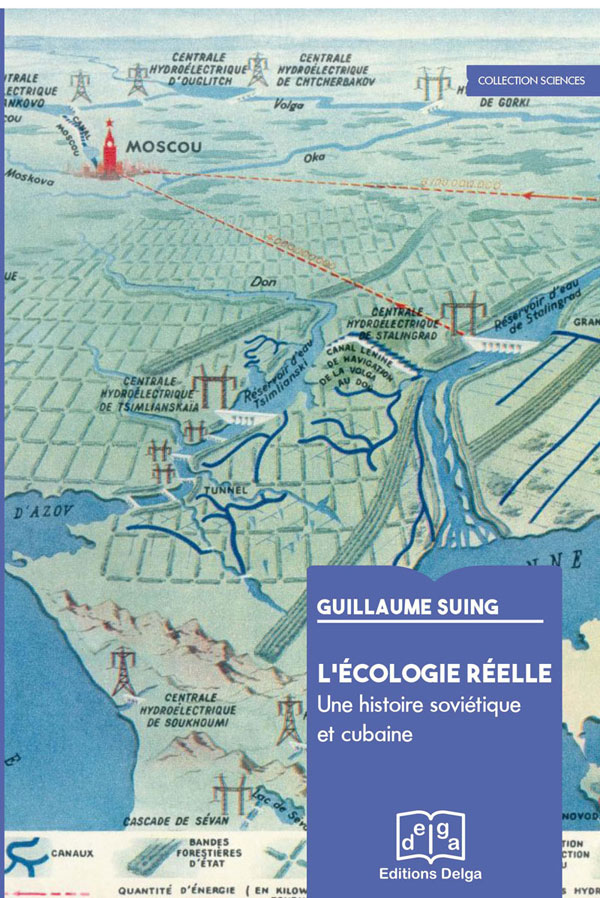Annual Report of Pollution Information Transparency Index (PITI) for 120 Cities in China.
by the Institute of Public & Environmental Affairs - January 2019
Since the first PITI report was published in 2009, we have evaluated China's pollution source information disclosure for ten years.
Throughout the ten years of continuous data collection and evaluation, we are fortunate to witness the historic progress of China's environmental information disclosure: from the first issue of "Breaking the Ice", to the fourth issue of "New Mindsets, Innovative Solutions", to the ninth issue "Moving towards Normalization", to today's "Achievements of One Decade", the ten titles of the PITI reports reflect the magnificent twists and historic progress of pollution information disclosure in China.
The decennial achievements are directly reflected in the increase of data quantity.

Institute of Public and Environmental Affairs (IPE)
The Institute of Public & Environmental Affairs (IPE) is a registered non-profit environmental research organization based in Beijing. Since its establishment in May 2006, IPE has developed the Blue Map Database (wwwen.ipe.org.cn), as well as the Blue Map app, the first Chinese environmental mobile app to track real-time pollution data, which went live in June 2014. IPE works to promote environmental information disclosure, public participation, and effective environmental governance strategies.
Natural Resources Defense Council (NRDC)
The Natural Resources Defense Council (NRDC) is an international nonprofit environmental organization that combines the power of more than 3 million members and supporters with the expertise of some 500 lawyers, scientists, and other environmental specialists. Since 1970, NRDC has worked to protect the world’s natural resources, public health, and environment in countries and regions including the United States, China, India, Canada, Mexico, Chile, Costa Rica, and the European Union. NRDC is headquartered in New York City and has offices in Beijing; Washington, D.C.; Chicago; Los Angeles; San Francisco and Bozeman, Montana.

Authors:
Institute of Public and Environmental Affairs (IPE): MA Jun, RUAN Qingyuan, GUO Ye, CHEN Yiting, HE Fanghui, ZHU Huaning, ZHU Li, GUO Huaxin, LI Zhenshan, LI Qingfeng, MA Yingying, DING Shanshan, CHEN Qifeng.
Natural Resources Defense Council (NRDC): WANG Yan, WU Qi, ZHANG Xiya, YANG Jia, Lena Suponya, Elizabeth Weinlein, QI Bokai
English Translation:QI Bokai, Elizabeth Weinlein, DING Shanshan, WU Qi, RUAN Qingyuan
Design:CHEN Shuangli
Acknowledgement:
- Thanks to the Alibaba Foundation PROJECT XIN, Ai You Foundation, and SEE Foundation for funding this report. The original text and suggestions are those of the author of this report and are not representative of those Foundations.
- IPE and NRDC would like to thank the following experts for their comments and guidance during the production of the report: JIA Feng, WANG Hua, WANG Canfa, WANG Jin, WANG Bidou, YANG Sujuan, YANG Ke, ZHU Xiao, GUO Hongyan, YAN Houfu and HU Jing.
- We would also like to thank the local Ecology and Environment Bureaus who are disclosing the information.
- IPE and NRDC would also like to thank Green Anhui, Green Qilu, Lvse Jiangnan, Fujian Green Home, Jiangxi Environment Communication Centre, Hubei Xingche Environment and our other environmental partners for their participation;
- and Blue Map volunteers for their contributions of data for evaluation.
Table of Contents
Introduction / 2
- The Origin: Where PITI Began / 4
- Ten-year Assessment: Ratings for 120 Cities over the Years / 7
- Ten-year Comparison: Historic Progress in Environmental Information Disclosure / 11
- Moving Towards Full Disclosure of Pollution Source Supervision Information / 11
- Timely Disclosure of Pollution Source Supervision Information / 16
- Complete Disclosure of Pollution Source Supervision Information / 18
- Disclosure of Pollution Source Supervision Information to be Platformized; Ecological and Environmental Public Services to be More User-Friendly / 19
- Ten-year Application: Information Disclosure and Innovative Environmental Governance Tools / 21
- Information Disclosure: Making Green Supply Chain More Effective / 21
- Information Disclosure: Realizing Dynamic Assessment of Enterprise Environmental Performance / 23
- Information Disclosure: Promote Public Supervision towards Larger Scale and Longer Term / 24
- Ten-year Impact: Enhance Social Trust and Foster Green Development / 28
- Information Disclosure, an Acceleration of Environmental Governance / 28
- Information Disclosure, to Restrict Compliance and Promote Corporate Responsibility / 30
- Information Disclosure, to Promote Social Trust / 33
- Information Disclosure, to Promote Green Transition and Development / 35
- Outlook: Great Potential for Information Disclosure / 37
- From Government Information Disclosure to Enterprise Information Disclosure / 37
- From Key Enterprises to More General Companies / 38
- China's First Large-Scale Real-Time Disclosure, to be Consolidated and Expanded / 39
- From General Pollutants to Characteristic Pollutants / 41
- From Local Pollutant Disclosure to Carbon Emissions Information Disclosure / 42
- From Stationary Sources to Mobile Sources / 43
Annex: Assessment Results / 44
Introduction
Since the first PITI report was published in 2009, we have evaluated China's pollution source information disclosure for ten years.
Throughout the ten years of continuous data collection and evaluation, we are fortunate to witness the historic progress of China's environmental information disclosure: from the first issue of "Breaking the Ice", to the fourth issue of "New Mindsets, Innovative Solutions", to the ninth issue "Moving towards Normalization", to today's "Achievements of One Decade", the ten titles of the PITI reports reflect the magnificent twists and historic progress of pollution information disclosure in China.
The decennial achievements are directly reflected in the increase of data quantity.
In 2006, our environment database, the Blue Map Database, could only collect about 2,000 corporate environmental violation records. When the PITI evaluation was launched in 2008, the records rose to 24,000. After ten years of collection and accumulation, the total number of records today is more than 1.6 million, and the total number of enterprise online emissions monitoring data exceeds 1.8 billion. A number of leading cities are achieving “what should be public needs to be made public.”
The decennial achievements are clearly reflected by the improvement on data quality.
Compared with the beginning of environmental information disclosure in China, most cities have switched from issuing a simple directory or list to issuing a complete administrative penalty decisions; greatly improving the integrity of information disclosure. Most of the information is released in a timely manner, and the real time automatic monitoring data from 23,000 companies is released to the public in real time. At the same time, the disclosure of pollution source information tends to be platformized, which is easier for the public to utilize.
Behind the decennial achievements is the institutionalization of information disclosure through laws and regulations.
From "Measures for the Disclosure of Environmental Information (Trial)" in 2008, to the "Measures for the Self-Monitoring Information Disclosure by State Monitored Enterprises (Trial)" in 2013, real-time and large-scale online data disclosure was implemented for the first time in the world. Additionally, the new Environmental Protection Law made an unprecedented section dedicated to information disclosure and public participation, establishing China's pollution source supervision information disclosure as comparable to the world's leading information disclosure regulations. "Openness is the norm, non-disclosure is the exception," has not only been established as a principle, but has also been gradually implemented through regulatory mechanisms.
The decennial achievements can also be observed from the perspective of data applications and utilizations.
With the strengthening of pollution source environmental supervision, the improvement of information disclosure and the public awareness of the importance of environmental protection, multiple aspects of pollution source information has begun to be applied on a large-scale. From the perspective of IPE and the green supply chain, a number of large-scale brands intensively cooperated with IPE and Green Choice Alliance (GCA) partners. In the past ten years, they have promoted thousands of companies to effectively rectify violations and achieve pollution reductions. From the perspective of social supervision, the Blue Map cooperated with Lvse Jiangnan and other partners to follow tens of thousands of key enterprises, and prompted more than 2,000 companies to publicly explain why they had violated the standards as revealed by online monitoring data. From the aspect of green finance, banks and financial institutions began to adopt big data-based dynamic corporate environmental credit evaluation systems and the banking financial industry has also begun to show great potential in promoting green transformation and low-carbon development.
At present, in the face of complicated situations such as the trade wars and economic downturns, we should take into consideration of local situations, instead of "one size fits all" type of polices. We should also prevent deregulation as it may cause bad performers to drive out good performers. There is an urgent need to find innovative solutions that balance environmental protection and economic development. Environmental data is the foundation for new ideas such as differentiated management and precision pollution control, as well as new technological approaches such as artificial intelligence and financial technology.
Looking forward to the next ten years, environmental information disclosure needs to continue to expand on the basis of today's solid foundation.
First, it needs to expand from disclosure of government supervision information to disclosure of corporate environmental information; from disclosure of monitored density to total emissions; from disclosure of general pollutants to particular pollutants; from disclosure of major local pollutants to energy and carbon emissions information; from State Monitored Enterprises to more general companies; from stationary sources to mobile sources.
In response to new needs and changes in disclosure methods, our information disclosure evaluation will also restart to a new stage. Starting in 2020, we plan to expand the evaluation to include more provinces and cities in a more digital way, focusing on reaching wide-ranging populations so that environmental supervision and emission information can better support the green development of China and the world!
Chapter I The Origin: Where PITI Began
In April 2007, the State Council promulgated the "Open Government Information Regulation of the People's Republic of China", followed by the former State Environmental Protection Administration promulgating the "Measures for the Disclosure of Environmental Information (Trial)" (hereinafter referred to as the "Measures"). The "Measures", which came into effect on May 1, 2008, initiated the institutionalization of environmental information disclosure in China. To clarify the baseline during the first year of environmental information disclosure, record every step of China's progress, identify and promot positive local practices, and advocate for the disclosure of environmental information, the Institute of Public and Environmental Affairs (IPE) and the Natural Resources Defense Council (NRDC) jointly developed the Pollution Information Transparency Index (PITI). The first evaluation results were released in June of 2009 and this year’s report is the tenth issue.
In our PITI project, in addition to IPE's assessment on the disclosure of pollution source supervision information in 120 cities nationwide (mainly key environmental protection cities), environmental organizations around the country are also actively conducting regional assessments, including Green Anhui, Green Qilu (Shandong Province), Fujian Green Home, Lvse Jiangnan (Jiangsu Province), Jiangxi Environmental Communication Centre (Jiangxi Province), Xingche Environment (Hubei), etc.1

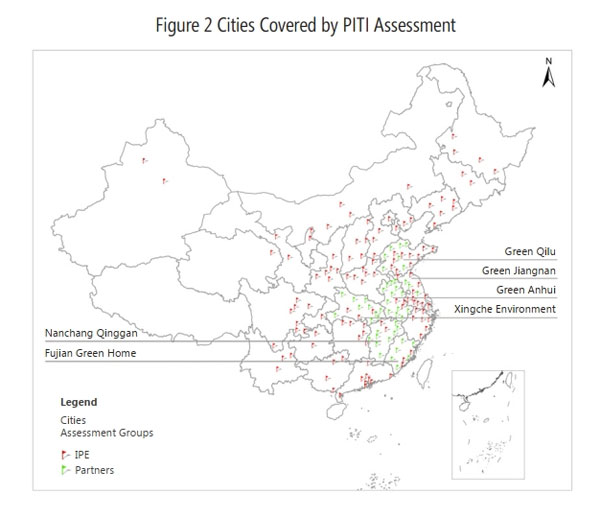
This integrated evaluation system includes five primary indicators: environmental supervision information, pollution source self-disclosure, interactive response, enterprise emission data and environmental impact assessment (EIA) information, as well as eight secondary indicators. Each indicator is measured from four dimensions: systematicness, timeliness, completeness, and userfriendliness.
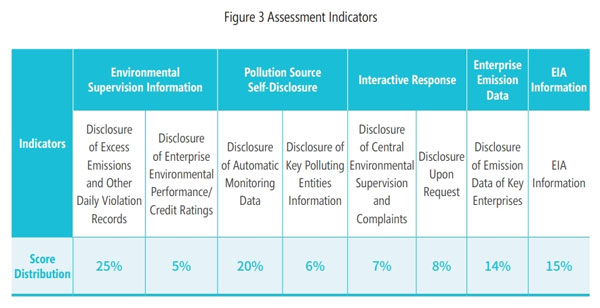
Chapter II - Ten-year Assessment : Ratings for 120 Cities over the Years
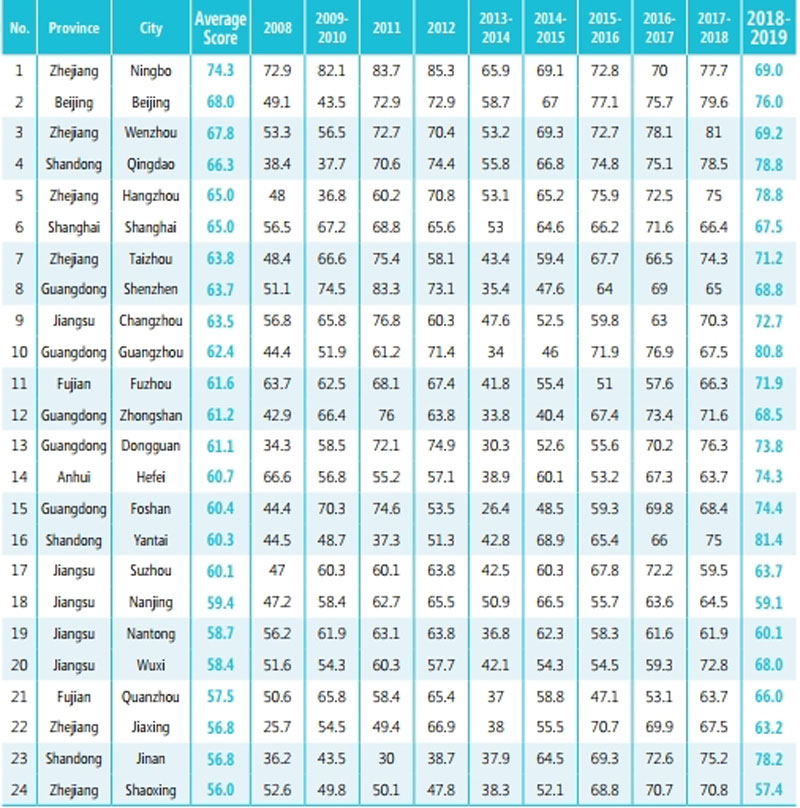
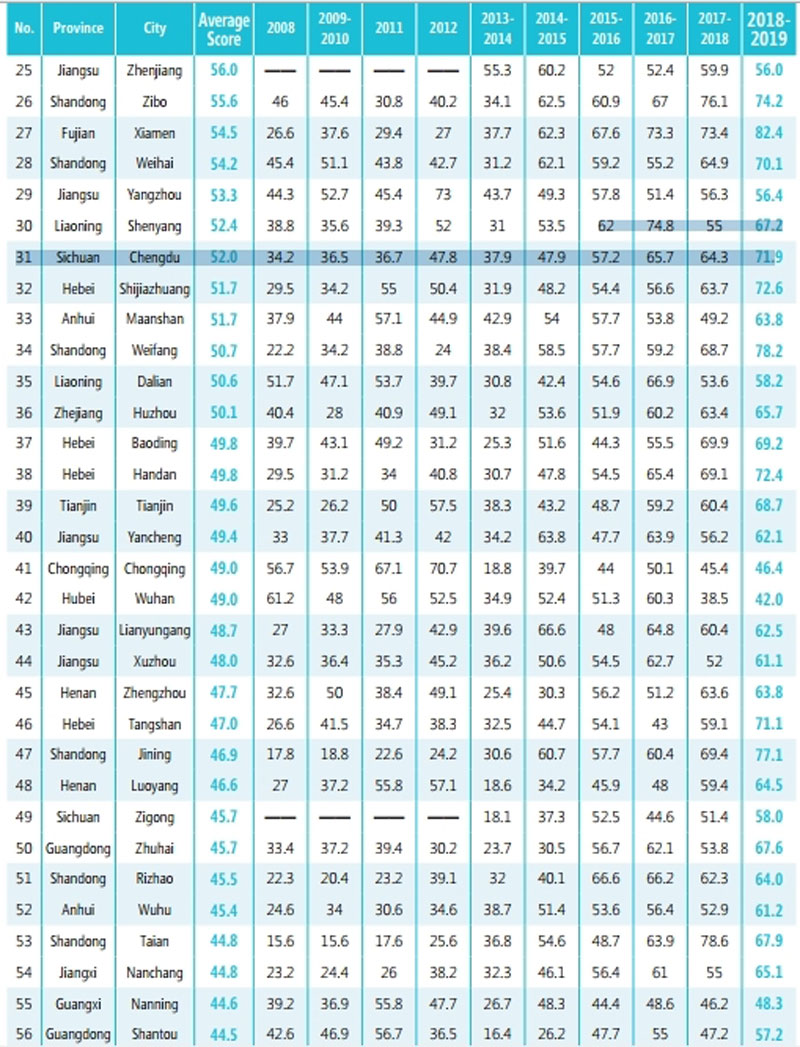
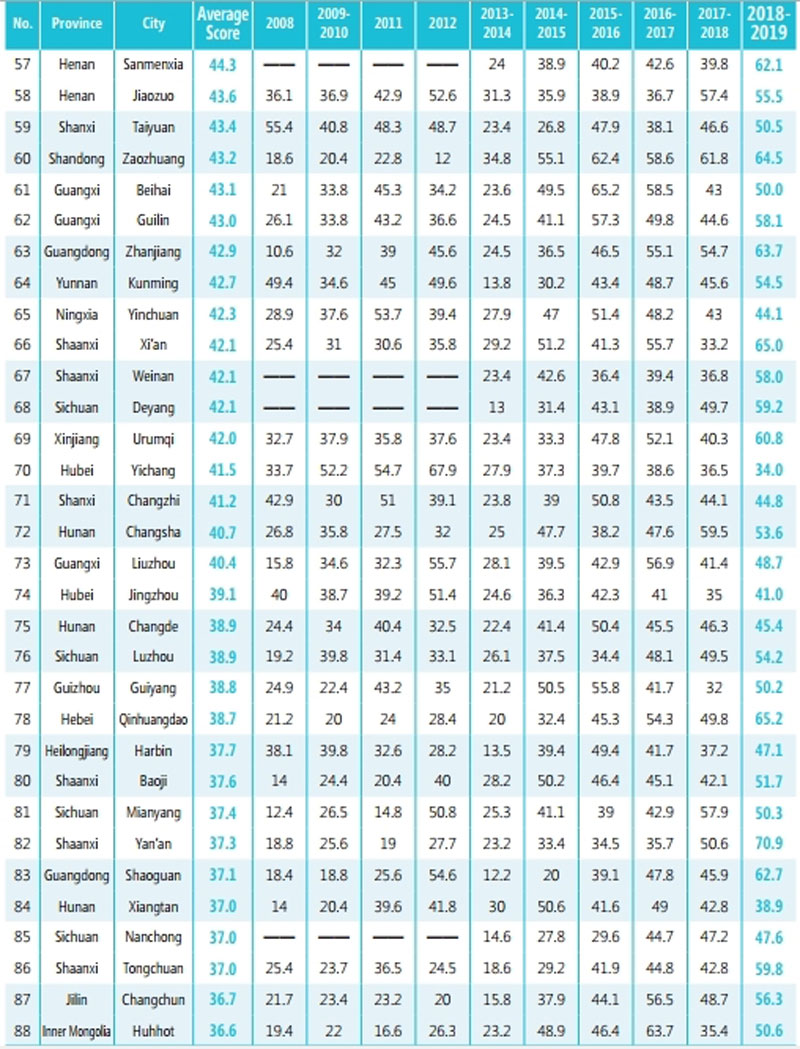

Chapter III - Ten-year Comparison : Historic Progress in Environmental Information Disclosure
Since the implementation of the Environmental Information Disclosure Measures in 2008, with the improvement of environmental legislation, the strengthening of supervision and enforcement, and the advancement of environmental informationization, with the common attention and promotion of all sectors of society, the disclosure of China's pollution source supervision information has made great progress in the dimensions of systematicness, timeliness, completeness, and user-friendliness.
1.Moving towards Full Disclosure of Pollution Source Supervision Information
Among the four dimensions of the PITI index evaluation, the first is about whether the information is fully and systematically disclosed. Early data was quite limited. The basis of the first PITI evaluation was 24,345 environmental supervision records published in 2008.
Following the new Environmental Protection Law of 2014, the basic data of the PITI evaluation reached 42,569. In 2016, the Central Government Environmental Protection Inspection began to roll out, and the data jumped to 69,355. In 2017, it further increased to 162,548. In 2018, the number reached 338,651.
Today, China’s environmental information disclosure has gradually formed a principle of “disclosure is the norm, and non-disclosure is the exception”. The official websites of many local and national environmental protection departments have established public information disclosure sections for pollution sources, and systematically carried out relevant work on information disclosure.
As a result, the categories and quantity of information available to the Blue Map based on official regulatory information disclosure have shown a surge in growth. As of October 2019, the Blue Map includes a total of 1.56 million corporate environmental violation records issued by environmental agencies of various levels throughout the country, of which more than 310,000 were obtained from January to October of 2019.
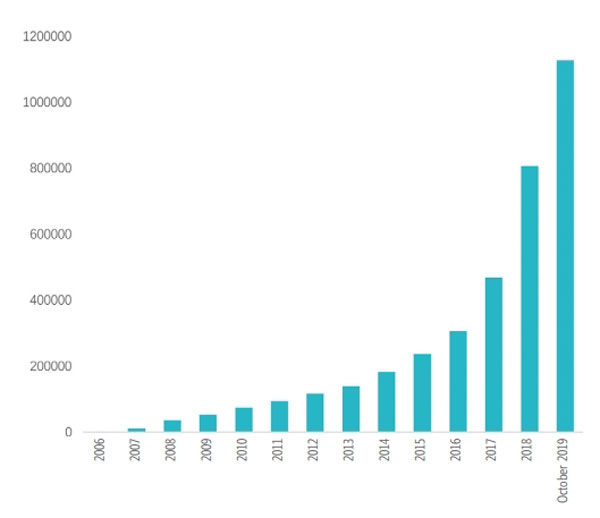
In January 2019, Minister LI Ganjie, at the 2019 National Working Conference on Ecological and Environmental Protection, stated that in 2018, 186,000 administrative penalty cases were imposed in China. As of November 12, 2019, the Blue Map had collected data a total of 257,000 pollution source violation records in 2018, of which 140,000 were administrative penalties, accounting for 75.3% of the number of national administrative penalties disclosed by the Ministry of Ecology and Environment. The acquisition rate had increased compared to the previous two years.
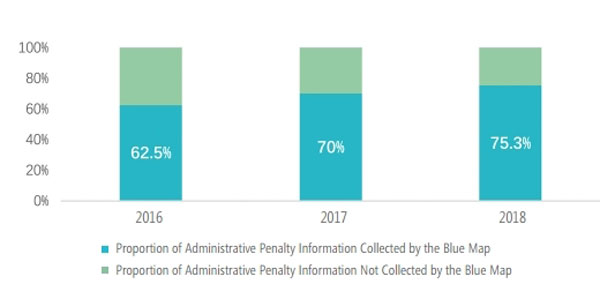
In early evaluations, the supervision information released by most cities was far from reaching the "estimated amount of pollution source supervision information.3" In the last three evaluations, this situation has improved. In 2016, the actual number of publicly available regulatory records in seven cities exceeded the theoretical amount that should be made public. In 2017, it reached 18 cities. Although the number fell to 15 cities in 2018, with the Fenwei Plain becoming the focus of governance, some areas with large emissions but large disclosure gaps significantly improved their level of information disclosure, including the provinces Shanxi, Shaanxi, Henan, and Anhui.
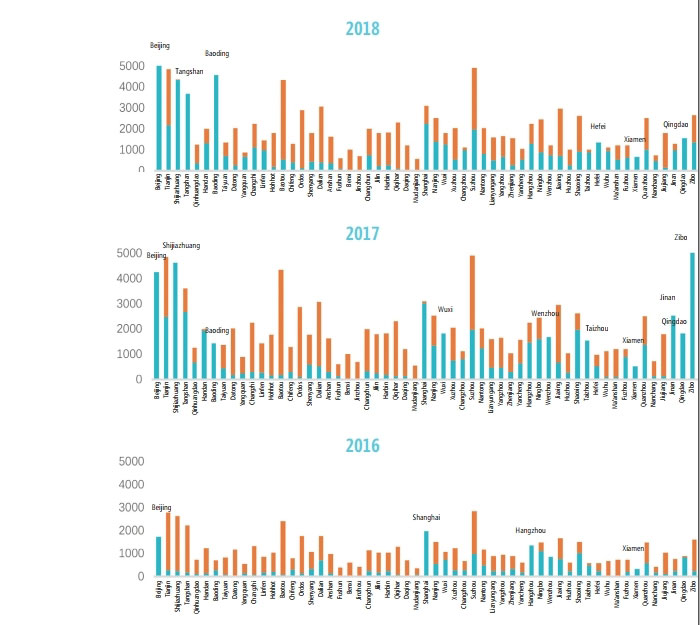
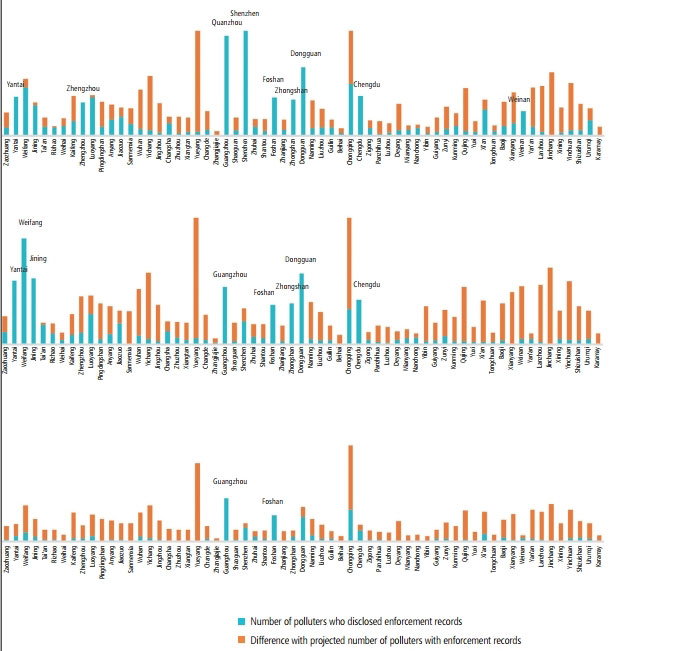
2. Timely Disclosure of Pollution Source Supervision Information
Earlier PITI evaluations found that there was a considerable delay in the disclosure of regulatory information on pollution sources in various places. At that time, the mass disclosure of regulatory records by the leading cities of information disclosure was considered good practice, but its frequency was limited to a half year or annual update.
After the results of the first PITI evaluation were released, the city of Ningbo actively responded to the delayed disclosure issue and implemented the timely release of pollution source supervision information. Since then, evaluation cities in Guangdong and other provinces have begun to timely release information on pollution source supervision, particularly administrative penalty decisions.
In 2013, the “Measures for the Self-Monitoring Information Disclosure by State Monitored Enterprises (Trial)” was issued, which required “state monitored enterprises” to conduct selfmonitoring and publicly disclose the monitoring results. The content, frequency, and channels of automatic monitoring data disclosure were standardized, which is a breakthrough in corporate environment self-monitoring information disclosure. The unprecedented measures also helped promoted the timely disclosure of pollution source supervision information.
“The Law of the P.R.C. on the Prevention and Control of Atmospheric Pollution” and “The Law of the P.R.C. on the Prevention and Control of Water Pollution”, which were subsequently revised, further required key polluting entities to “install automatic monitoring equipment and connect with environmental protection authorities” to conduct self-monitoring.
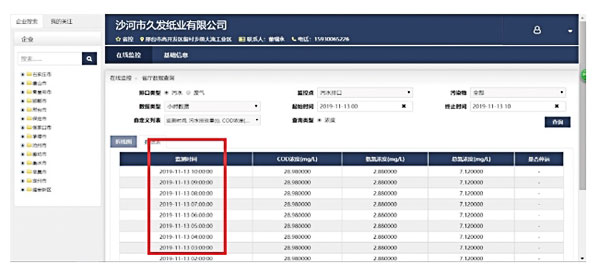
The Blue Map has been collecting automatically monitored pollution source data from various environmental department platforms since 2013. In the last six years, the number of companies with online monitoring data that can be accessed through public platforms has grown from more than 6,000 in 2014 to more than 20,000 at present.
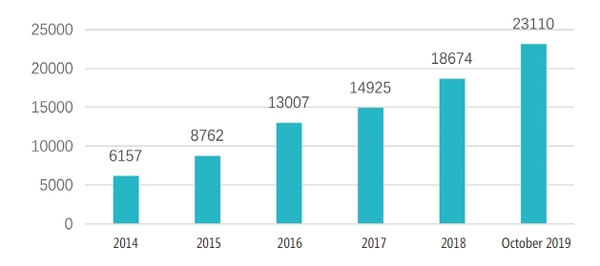
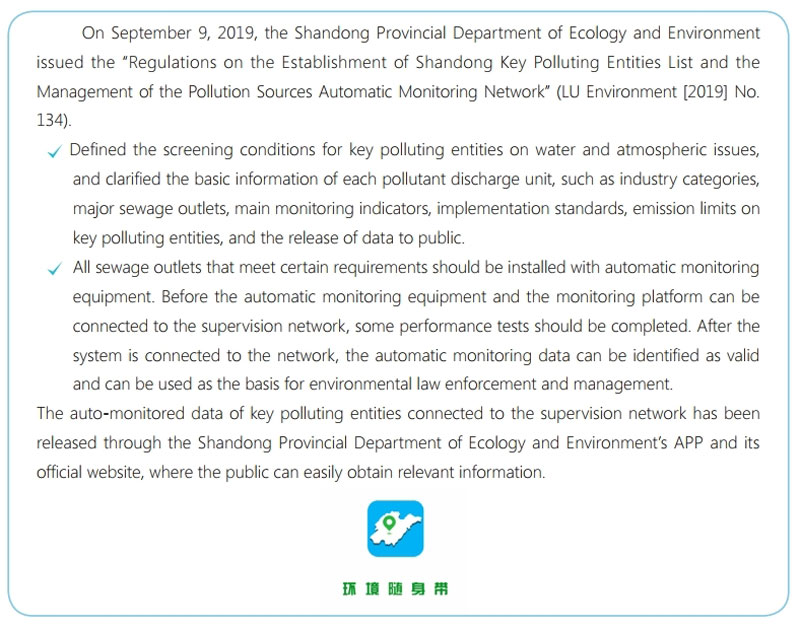
3. Complete Disclosure of Pollution Source Supervision Information
In the four dimensions of the PITI index evaluation, the integrity of the information, “completeness,” has received low score for a long time.
Taking environmental administrative penalty decisions as an example, in the early years, we only had access to the list of punished companies, which lacked specific violation facts, the legal basis for penalties, data on fines. Sometimes, even the companies’ names were hidden by code.
With the strengthening of the disclosure of environmental supervision information on pollution sources, starting in Beijing and other cities, the full text of the penalty decision is now available and includes the name of the violator, their legal representative, unified social credit code, address, detailed violation facts (including pollutants’ names, monitored densities, multiples of exceeding the standard, etc.), punishment basis, and enforcement opinions.
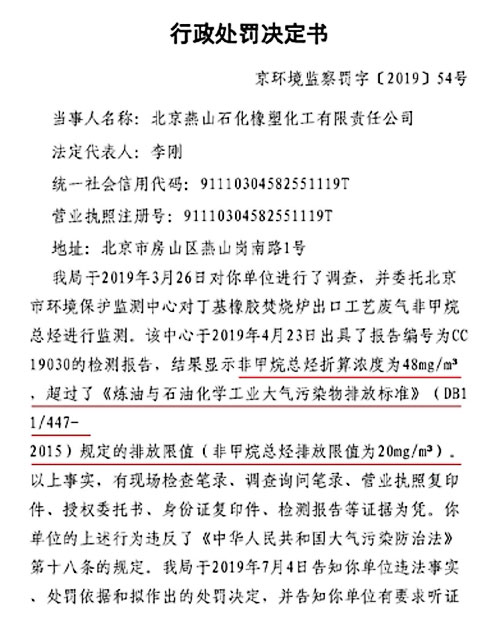
In the early PITI index evaluation, the disclosure of emission concentration data was extremely rare. Since 2013, the situation has changed, and the public can learn about the emission concentration data of key monitored enterprises through the quarterly regulatory/supervisory monitoring reports released by local environmental bureaus in various cities. This year's evaluation found an increasing number of key polluting entities’ monitoring data disclosure has become systematic and platform based.
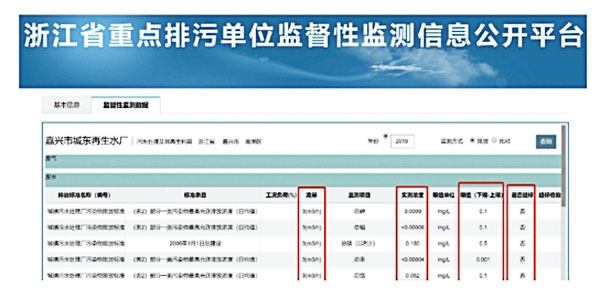
In the past, environmental impact assessment information only had the simple requirement of being publicize for review Since 2013, the complete environmental impact assessment reports or forms are required to be publicized and made available to the public.
4. Disclosure of Pollution Source Supervision Information to be Platformized; Ecological and Environmental Public Services to be More User-Friendly
The disclosure of polluting source information enables the public to access data and information. In spite of this, international experiences have illustrated that not all bureaus who are in charge of information disclosure are willing to make it easy for public to access and use.
Earlier PITI evaluations found that some of the evaluated cities didn’t even have an official environmental protection website. Most of the regions that had an official website did not have a separate column for corporate regulatory information release. The query and retrieval of pollution source regulatory information was like looking for a needle in a haystack.
With the advancement of government Internet access projects and the construction of big data on ecological environment, all PITI-assessed cities now have official environmental protection websites, and subsequently opened columns to publish pollution source supervision information, supporting search tools to further facilitate public information retrieval. Cities of Beijing, and from Zhejiang, Shandong, Guangdong provinces are leaders in innovative and informative website design.
With the advancement of environmental informatization construction, the release of various types of environmental data in China tends to be platform-based and systematic. Common environmental data platforms include, but are not limited to: real-time air quality release platform, dual publicity platform for administrative penalty and approval results, supervisory monitoring information release platform, key monitored enterprises online data disclosure platform, 12369 Hotline complaint reporting platform, environmental impact assessment information publicity platform, enterprise and public environmental disclosure platform.
The platform-based information release form has the advantages of highly integrated information and convenient retrieval /query, which greatly facilitates public access to environmental information.
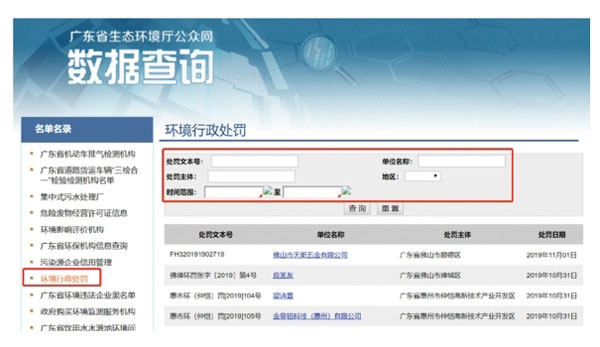
Moving into the mobile Internet stage, a number of the leading cities have also turned to social media for polluting source information disclosure. Weibo, Wechat and Mobile APP have reduced the threshold for the public to obtain data and promoted user friendly interaction.
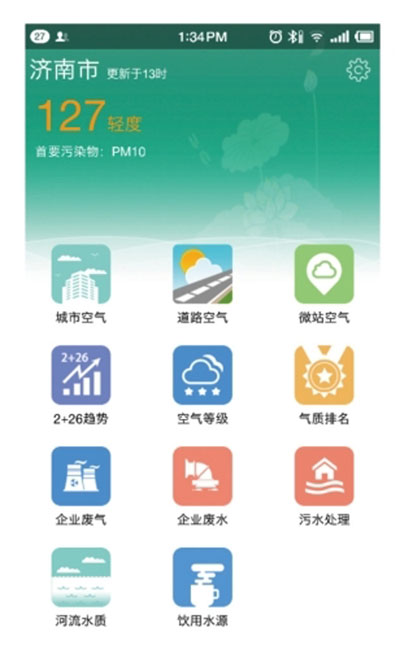
Chapter IV. Ten-year Application: Information Disclosure and Innovative Environmental Governance Tools
The decennial achievements, can also be observed from the perspective of data applications and utilizations.
With the strengthening of environmental supervision, the improvement of information disclosure, and the improvement of public awareness, environmental information of pollution sources has begun to be applied on a larger scale, in multiple directions, such as in supply chain management and public supervision. In the direction of green supply chain, more innovative solutions are being formed based on information disclosure; in the direction of green finance application, with the application of big data-based corporate environmental credit dynamic evaluation system, the huge potential to promote green transformation and low-carbon development will gradually be explored.
1. Information Disclosure: Making the Green Supply Chain More Effective
Being the 'world factory', China has witnessed the deterioation of the environment for the past decades. When the predecessor of the Blue Map, Pollution Map, was released in 2006, it was identified that a number of Fortune 500 Companies had environmental violations in their factories in China. To promote solutions, in March 2007, IPE and 20 other environmental organizations jointly launched the "Green Choice Initiative," which advocates "large brands and retailers to green their supply chains." In the early days of the initiative's launch, the regulatory information that Blue Map could collect was quite limited, and the number of companies promoting the improvement was no more than a few dozen a year.
Since 2013, three major environmental protection campaigns, for air, water and soil, have been initiated. In 2016, the Central Government Environmental Protection Inspection campaign was rolled out across the country. In 2018, the blue-sky defense battle and the pollution battle were began, and the environmental supervision and information disclosure have been greatly improved.
With the transformation of corporate violation risks into supply chain risks, green choice supply chain projects based on the disclosure of environmental regulatory data have also generated more impacts on companies along the supply chain. As of 2019, more than 10,000 companies have improved their environmental performance or have made public disclosures following the requirement of their brand customers.
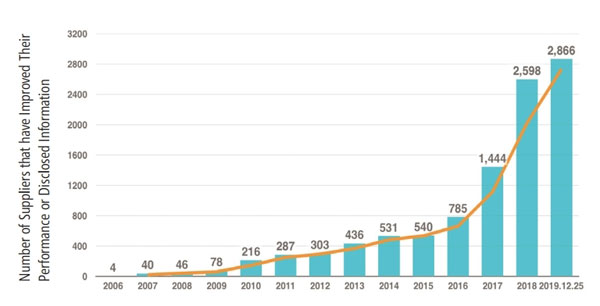

In a manner similar to the blockchain, the Blue EcoChain will not only enable brands and suppliers to get connected based on data but also provide new approaches to data-based environmental management solutions. Environmental group Lvse Jiangnan for example, has pushed hundreds of industrial facilities to register for corporate accounts and keep track of their environmental performance. Lvse Jiangnan has also made connection with local environmental enforcement bureaus. (See Case Study in Figure 18: Lvse Jiangnan)
2. Information Disclosure: Realizing Dynamic Assessment of Enterprise Environmental Performance
In 2013, the former Ministry of Environmental Protection, the National Development and Reform Commission, the People's Bank of China, and the China Banking Regulatory Commission issued the “Measures for Enterprise Environmental Performance Rating (Trial),” which was carried out for enterprises with large total pollutant emissions, high environmental risks, and large environmental impact, and through joint construction of a "trustworthy incentives, disciplinary punishment" mechanism, to urge companies to continuously improve behaviors.
At present, many provinces and cities have carried out relevant evaluations and conducted practical applications in areas such as green credit and government procurement. Shandong Province has pioneered the application of dynamic scoring methods with a scope of facilities from across the province. It has also established a write-off mechanism to restore the environmental credit, with aim of motivating facilities to rectify their violations in a timely manner.
In 2016, seven ministries and commissions issued the “Guiding Opinions on Building a Green Financial System,” encouraging third-party professional institutions to participate in the collection, research, and release of corporate environmental information and analysis reports. As a member of the Green Finance Commission, Blue Map started to develop a model, called “The Dynamic Environmental Credit Risk Assessment Model.” The model is based on the 1.8 billion environmental data on the Blue Map. After all the data is structured and analyzed, the model is quantified and scored in a dynamic evaluation manner, drawing a real-time portrait of the environmental performance for the enterprise, and providing users with a quantification of the environmental risks of the pollution source evaluation result.
This tool is now being applied to green supply chain and green finance projects. Brands and financial units can quickly screen for major risks through the evaluation results and adopt measures such as promptly promoting the rectification of polluting enterprises to avoid and reduce operational risks and achieve a win-win situation for economic and environmental interests.
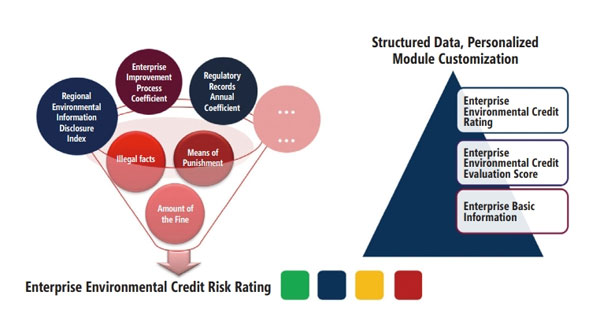
IPE is developing a green supply chain dynamic risk management system “DERA” in cooperation with industry experts. In addition to focusing on the company's own environmental compliance risks, DERA also includes policy planning, regulatory conditions, infrastructure and environmental quality in the region, providing users a big data-based comprehensive risk assessment tool.
3. Information Disclosure: Promote Public Supervision towards a Larger Scale and Longer Term
In the era of big data, the rise of smartphones has diversified information distribution channels, which greatly facilitated the public's access to information. This convenient access to information has also encouraged the public to express their environmental concerns through online movements such as "#pollution" and "#blue-sky". In addition, in the information era, the government has also launched a new “Internet +” service model. The emergence of government operated environmental microblogs, WeChat accounts, and 12369 Hotline reporting platforms has also greatly stimulated the public's enthusiasm for participating in the supervision and reporting of polluting enterprises.
Among them, the Blue Map mobile app contains an “Easy-informant” reporting section where more than 2,000 companies have responded to their online data excessive emissions more than 3,000 times. The environmental organization Lvse Jiangnan has conducted a strong supervision of pollution sources based on this data. In 2017, Lvse Jiangnan reported a total of 921 emission violation companies online, of which 274 provided feedback, and 37 illegal emission companies were investigated and punished by the according environmental department. In 2018, Lvse Jiangnan made even greater breakthroughs in the supervision of heavy pollution sources, reporting that 1,559 companies had exceeded their standards, and 72% of the reports were responded to and verified. Among them, 191 illegal emission companies were ordered by the appropriate environmental department to make corrections, pay the administrative penalties, or file a case for investigation.5
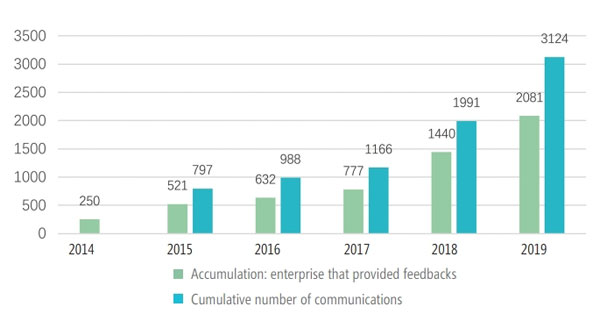
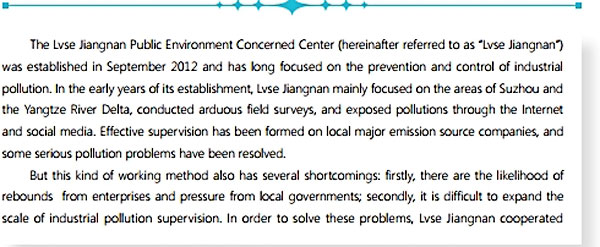
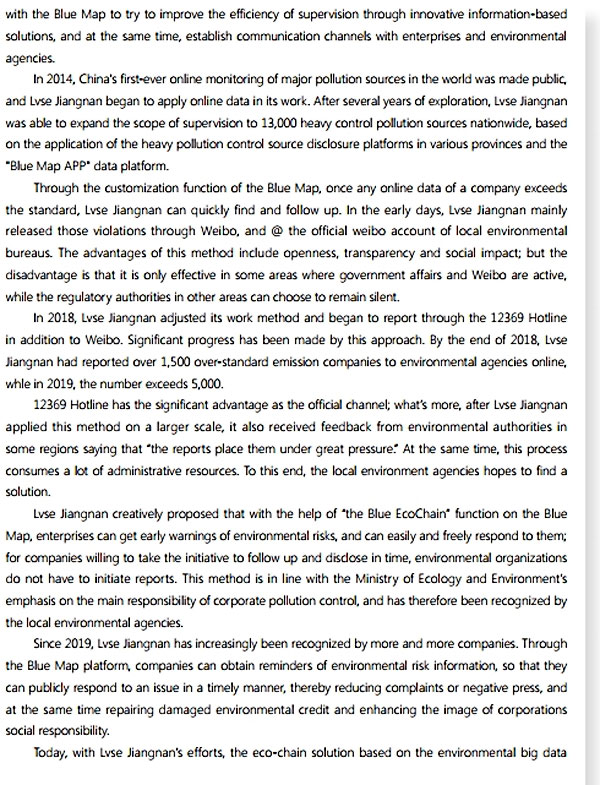

The successful practice of Lvse Jiangnan provides precious takeaways for the establishment of a large-scale environmental management pattern of government supervision, corporate participation, and public supervision in the information age.
Chapter V Ten-year Impact: Enhance Social Trust and Foster Green Development
During the ten year evaluation period, the gradual and transparent disclosure of information has played a positive role in improving the progress of government environmental governance, strengthening public trust in the government, and resolving social conflicts. In the meantime, the environmental quality has also been improved.
1. Information Disclosure, an Acceleration of Environmental Governance
Since the launch of the Air Pollution Control Plan, the quality of the atmospheric environment for key areas across the nation has improved significantly. The communiqués of National Environmental Conditions over the years show that the rate of compliance with urban air quality standards has been steadily increased from 4.1% in 2013 to 35.8% in 2018.7
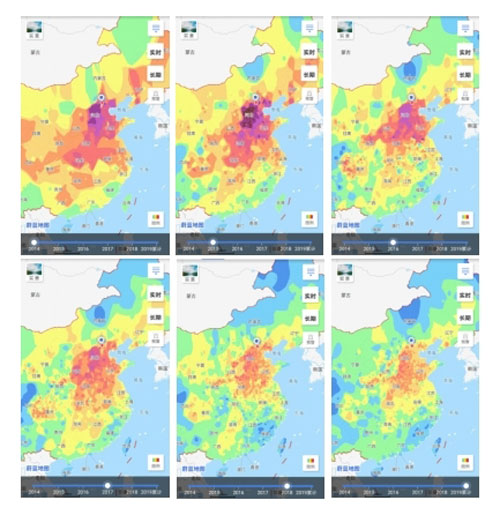
Changes in air quality and changes in information disclosure require more in-depth correlation analysis. The project team only made a preliminary comparison of the synchronization of changes in the two major areas.
The project team selected PITI cities8 in Shandong, Hebei, and the Fenwei Plain for comparison to evaluate the disclosure of urban pollution source supervision information and the annual PM 2.5 average.9 From 2013 to 2018, the average PITI index in Shandong and Hebei showed a steady upward trend. In Fenwei Plain, the assessment cities of pollution sources publicly stagnated during the period from 2014 to 2017.
In contrast, PM 2.5 concentrations in Shandong and Hebei showed a steady decline trend, while the PM 2.5 concentrations 10 in PITI’s designated cities in the Fenwei Plain fluctuated and even rebounded.
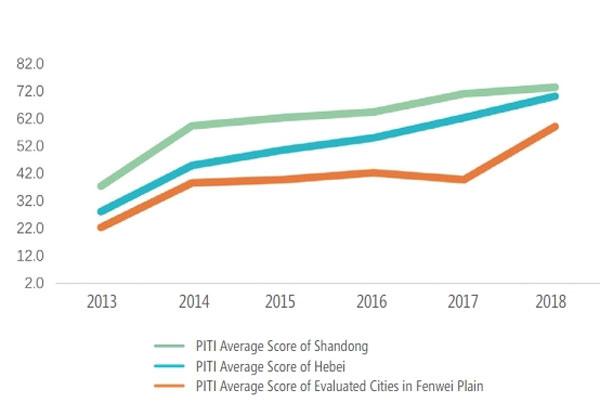
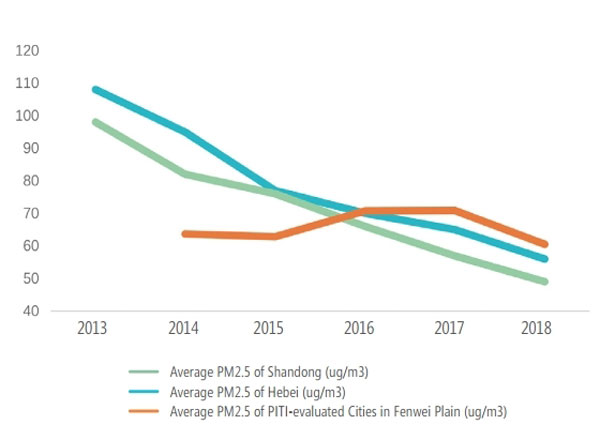
2. Information Disclosure, to Enhance Compliance and Promote Corporate Responsibility
According to information released by the Ministry of Ecology and Environment, in 2014 there were only 83,000 environmental administrative penalties nationwide. By 2017, the number of administrative penalties had increased to 233,000, and in 2018 it was 186,000. The number of penalties dropped slightly compared to 2017. From January to October of 2019, there were 124,500 environmental administrative punishment cases nationwide, with a total fines of RMB 9.277 billion and RMB 74,500 on average, a drop of 14.23%, 21.57%, and 8.56% respectively11 Under the current supervision intensity, the decline in environmental punishment cases has also confirmed that more and more companies are increasingly becoming environmentally compliance.
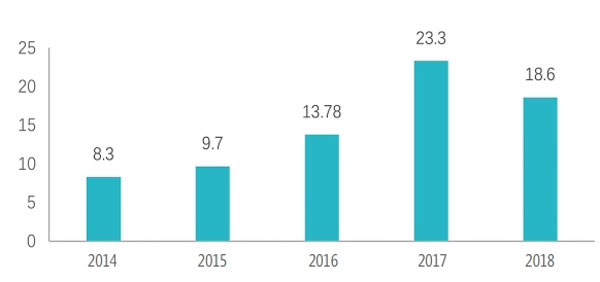
The improvement of corporate environmental compliance stems from the top-down restrictions represented by the central environmental supervision and special supervision by the Ministry of Ecology and Environment; on the other hand, as mentioned in the previous chapter, it also stems from the bottom up efforts of green supply chain, green finance, and social supervision. With the current downward pressure on the economy and the emphasis on "reforms to streamline administration, delegate powers, and improve regulation and services", bottom-up supervision and promotion will play a more important role in preventing deregulation, achieving differentiated management and accurate pollution control. The foundation of all these advances is the full disclosure of pollution source monitoring /supervision information.
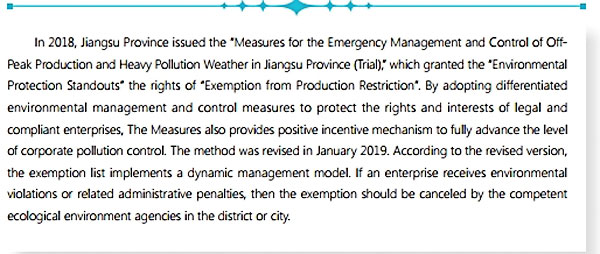

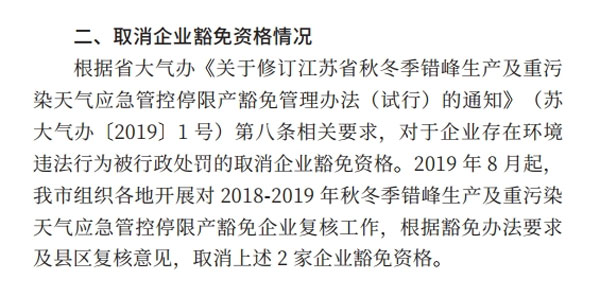
3. Information Disclosure, to Promote Social Trust
As Professor MA Liang from Renmin University and YU Wenxuan from Xiamen University co-authored in the article “Subjective and Objective Air Quality in Urban China: The Moderating Effect of Environmental Transparency,” the government's vigorous release of various environmental information reflects strong transparency and accountability, which can win people's trust in the government. If government agencies dare to proactively disclose various types of environmental information, the public will think that the government will take practical and effective measures to prevent environmental pollution. 13
The disclosure of environmental information by companies also helps to win the trust of the public and bridge the gap between them. Taking the household waste, sewage and industrial hazardous waste disposal projects that frequently face NIMBYism as examples, many enterprises in the early stage still lack the awareness of basic environmental responsibility and cannot even comply with environmental laws. The rough environmental management and lax pollution prevention and control have brought serious distress and impact to the local community, causing many residents to have an attitude of resistance.
How to solve the “Not in My Backyard (NIMBY-ism)” problem? Judging from domestic
and international experience, in addition to strengthening government supervision, corporate
compliance, emission reduction, and popularization of science, it is particularly critical for
companies to establish a responsible image and build trust with local communities and the public.
Opening up environmental protection facilities, including household waste and sewage treatment facilities, to the public, is an important measure to protect the public's environmental rights and interests. This is a starting point for building social trust and is significant for the longterm development of the environmental protection industry itself.
In September 2018, the “Notice on Further Opening of the National Environmental Protection Facilities and Urban Sewage Waste Treatment Facilities to the Public,” jointly issued by the Ministry of Ecology and Environment and the Ministry of Housing and Urban-Rural Development, deployed and arranged the opening of environmental protection facilities in stages. By promoting the opening up of environmental protection facilities, more and more facilities changed from “staff only” facilities to “urban living rooms” for the residents, ensuring public's rights to know, participate, and supervise. “Seeing is believing,” which increased the public's trust in the government and enterprises, and effectively solved the NIMBY-ism dilemma. 14
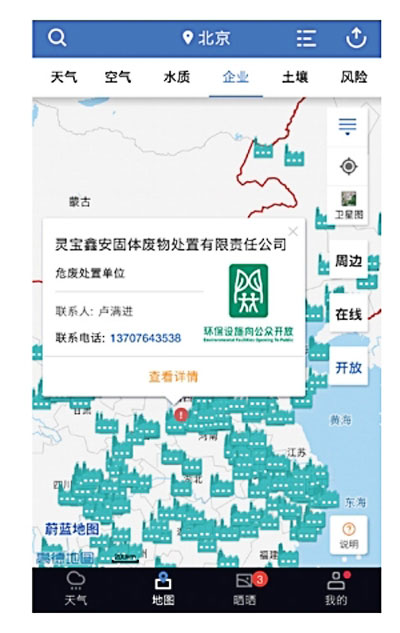
On December 13, 2019, under the guidance of the Ministry of Ecology and Environment, 13 waste incineration companies took the lead in making environmental compliance and information disclosure commitments to the society. The implementation of such measures included the installation and real-time disclosure of online monitoring equipment.
According to the “Administrative Regulations on the Application of Automatic Monitoring Data for Domestic Waste Incineration Power Plants,” from January 1, 2020, “the ecological environment agencies can use automatic monitoring systems as evidence of environmental violations.” Starting from 2020, 401 domestic waste incineration power plants across the country will disclose the daily average values of five conventional pollutants, which include particulate matter, nitrogen oxides, sulfur dioxide, hydrogen chloride, and carbon monoxide. The incineration plants will also disclose automatic monitoring data of incinerator furnace temperatures and accept social supervision.15
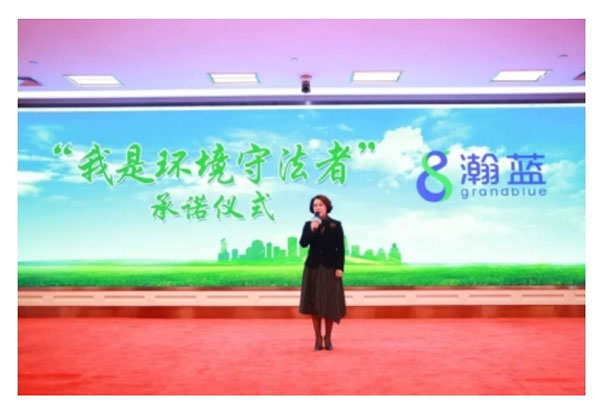
4. Information Disclosure, to Promote Green Transition and Development
In the face of economic downturns, strong environmental protection measures may encounter more obstacles in the implementation stage, leading to the failure of local government’s environmental management; however simple market mechanism have failed in solving environmental problems,16 and the market has long been in the situation of “bad money drives out good.”
The comprehensive and transparent disclosure of pollution source information will not only force the company to abide by the law, but more importantly, it can overcome the misguided driving mechanism of “bad money drives out good”. Additionally, pollution disclosure will help form a more equitable competition environment and gradually transform the company's own environmental performance into the company's internal demand, helping the green transformation and sustainable development of society and the economy.
In June 2016, SEE Foundation, CURA, China Real Estate Chamber of Commerce (CRECC), Vanke and Landsea jointly launched a green supply chain initiative17 in the real estate industry. Blue Map was invited as a third-party professional organization to develop a whitelist of real estate green chains based on environmental big data. As of September 5, 2019, 3,662 companies from steel, cement, building materials, and home improvement and other upstream industries have been enlisted in the green chain action whitelist. For the first time in 2019, CURA will apply the "Real Estate Green Chain White List" in their joint purchases
Landsea Group, one of the founder, said at the 2019 Green Supply Chain Forum that it has continuously traced environmental issues of 181 suppliers through the Blue Map database platform and has included environmental compliance requirements in bidding documents, required suppliers to complete screening before bidding, and will gradually extend their influence to upstream suppliers. Landsea bluntly stated that "this work has not increased the cost of our purchase. Instead, it allows us to identify which partners in the industry chain have more standardized, stable and sustainable production management.”
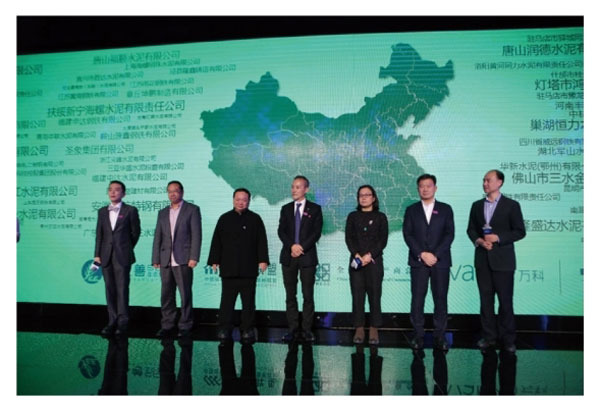
Chapter VI Outlook: Great Potential for Information Disclosure
The disclosure of pollution source supervision information has effectively promoted multiple stakeholders’ acknowledgement and participation, which has effectively advanced pollution reduction and environmental quality improvement. At present, in the face of complicated situations such as the trade wars and economic downturn, we should take into consideration of local situations, instead of "one size fits all" type of polices. We should also prevent deregulation as it may cause bad performers to drive out good performers. There is an urgent need to find innovative solutions that balance environmental protection and economic development. Environmental data is the foundation for new ideas such as differentiated management and precision pollution control, as well as new technological approaches such as artificial intelligence and financial technology.
Looking forward to the next decade, protecting the ecological environment and public health, as well as achieving a green transition and low-carbon development, will require more comprehensive disclosure of environmental information on pollution sources. The rapid development of IT technology and information infrastructure all mean that China's environmental information disclosure has strong potential.
1. From Government Information Disclosure to Enterprise Information Disclosure
In January 2019, Minister LI Ganjie pointed out at the National Conference on Ecological Environmental Protection that in 2018, 186,000 administrative penalties were imposed in China, down from 233,000 in 2017. No matter if it’s 186,000 or 233,000 penalties, compared to the total number of manufacturing enterprises in the country, they account for only a small fraction. Therefore, relying solely on government supervision and law enforcement information hardly meets the needs of society for information on pollution sources in the information era.
Article 55 of the newly revised “Environmental Protection Law of the People's Republic of China” stipulates mandatory information disclosure requirements for key pollutant discharging entities. “Pollutant discharging entities under intensified supervision shall honestly disclose to the public the names of their major pollutants, the discharge methods, the concentration and total volume of pollutants discharged, any discharge beyond the approved quota, and the construction and operation of pollution prevention and control installations to receive supervision from the general public.” Article 42 of the "Administrative Measures for Emission Permits (Trial)" (Ministerial Decree No. 48) stipulates that, “discharging entities shall publicize the relevant emission information, and consciously accept public supervision.” Under the requirements of relevant laws and regulations, key pollutant discharge entities have carried out relevant self-monitoring disclosure work, and some regional government departments have also actively established platforms as channels for corporate self-disclosure.
The environmental information of pollution sources that society can obtain has been expanded from government regulatory information disclosure to corporate self-disclosure. The future coverage and information breadth are worth looking forward to.
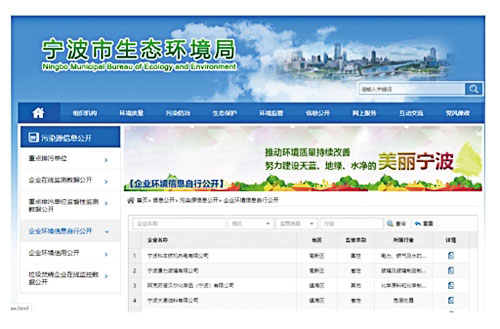
2. From Key Enterprises to More General Companies
In 2016, the People's Bank of China, the Ministry of Finance, the National Development and Reform Commission, the Ministry of Environmental Protection (formerly), the China Banking Regulatory Commission, the China Securities Regulatory Commission, and the China Insurance Regulatory Commission jointly issued the "Guiding Opinions on Building a Green Financial System" (PBOC [2016] No. 228), which requires the gradual establishment and improvement of the mandatory environmental information disclosure system for listed companies and bond issuers. In 2017, the “Implementation of the ‘Guiding Opinions on Building a Green Financial System’ ” was launched, and included plans to establish a mandatory disclosure of environmental information system by listed companies in a step-by-step manner: the first step is to revise the content and format guidelines of listed companies' voluntary reports by the end of 2017; in the second step, semi-mandatory disclosure requirements are implemented for all listed companies while those who are key pollutant entities have mandatory disclosure requirement (explanations are required for non-disclosure) (March 2018); the third step, mandatory requirements for all listed companies (before December 202018). In addition to mandatory information disclosure, listed companies are also encouraged to voluntarily disclose relevant information that is conducive to ecological protection, pollution prevention and environmental responsibility.
At the 2018 Beijing Green Finance International Forum, CHEN Yulu, deputy governor of the PBOC, said that in the future, China will further study and promote the mandatory environmental information disclosure of various market entities, and establish uniform standards for the content, format, and scope of information disclosure to continuously improve the green financial markets.19
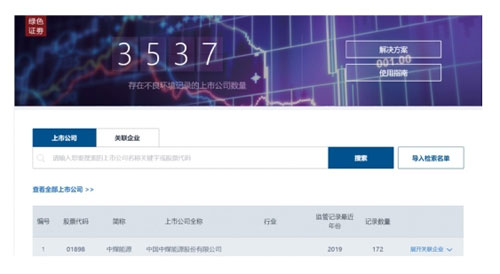
3. China's First Large-scale Real-time Disclosure, Consolidation and Expansion on the Way
The “Measures for the Self-Monitoring Information Disclosure by State Monitored Enterprises (Trial)” requires State Monitored Enterprises to conduct real-time disclosure of online monitoring data. In the nearly six years since the implementation of the “Measures”, relevant disclosure platforms and mechanisms have been gradually established in various places. Later amendments to the “Law of the People's Republic of China on the Prevention and Control of Atmospheric Pollution” and the “Law of the People's Republic of China on Prevention and Control of Water Pollution” further required key pollutant discharging entities to “install automatic monitoring equipment and network with monitoring equipment of environmental authorities.” According to our observations, some regions have already carried out the installation and networking of automatic monitoring equipment for key pollutant discharging entities.
Automatic monitoring has the advantage of continuous online operation. It is a “cuttingedge guard” that monitors the discharge behavior of pollutant discharge units, which is helpful in removing blind spots and dead ends in environmental supervision.20 Online monitoring of pollution sources shows that China's environmental monitoring of pollution sources has shifted from manual to automatic, from coarse to precise, from decentralized to centralized and integrated linkage.21 The information disclosed is of great significance to the public's knowledge and participation in environmental protection. However, there are two problems with the disclosure of automatic monitoring data of pollution sources:
- Due to technical issues such as new information disclosure requirements and platform integration and transition, the online monitoring data disclosure of the former “State Monitored Enterprises” in Hubei, Hunan, Sichuan, Guizhou and other regions has regressed.
- Except for Shandong, Zhejiang, Beijing and other leading regions of information disclosure, the automatic monitoring and networking data of key pollutant discharge entities has not been fully disclosed to the society, which is not conducive to public supervision. In this issue of PITI evaluation statistics, 22% or 1,369 out of 6,318 key gas-related pollutant discharge entities (excluding the original state-controlled ones) from the 120 cities under evaluation published their online monitoring data. Although an increase from 12%22 in the first year of the implementation of the new Law of Atmospheric Pollution Control, the rate requires further improvement.
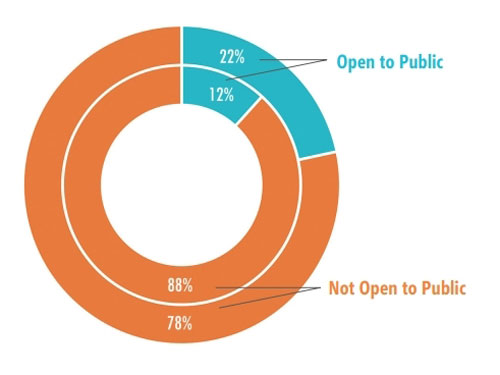
The expansion of enterprises that install automatic monitoring equipment and the disclosure
of relevant information to the society will further facilitate government departments to fully grasp the pollutant discharge situation in their jurisdictions, use environmental information to make precise environmental decisions and management, and help the market develop corresponding innovative environmental governance mechanisms to assist pollution control and encourage public supervision on pollution reduction
4. From General Pollutants to Characteristic Pollutants
Reducing pollutant emissions is the fundamental means for improving the quality of the environment, and information disclosure on pollutant emissions helps to achieve this goal.
The “Measures for the Self-Monitoring Information Disclosure by State Monitored Enterprises (Trial)” issued in 2013 requires State Monitored Enterprises to conduct self-monitoring and promptly disclose information on pollutant emissions, including the annual discharge of wastewater and exhaust gas pollutants; the new “Environmental Protection Law of the People's Republic of China” highlights the important status of information disclosure and public participation as a management tool. Article 55 clearly states that key pollutant discharge entities need to disclose information on their total pollutant emissions to the public; the newly revised “Law of the People's Republic of China on Prevention and Control of Water Pollution” Article 32 stipulates that “enterprises and institutions and other manufacturers and operators that discharge toxic and harmful water pollutants specifically listed in the preceding paragraph shall monitor the sewage outlets and the surrounding environment, assess environmental hazards, investigate hidden environmental risks, disclose information on toxic and harmful water pollutants, and take effective measures to prevent environmental risks." The above provisions have laid a legal basis for the disclosure of pollutant information from pollutant discharge entities in China.
According to the regulations above, our project team surveyed 20,866 key pollutant discharge entities from the 120 evaluation cities and obtained annual reports from 9,478 companies through Internet channels, accounting for 45.42% of the companies surveyed. Among them, 5,550 annual reports disclosed information on total pollutant emissions, accounting for 26.6% of the total number of surveyed companies; 2,008 annual reports had information about total emissions of characteristic pollutants, accounting for 9.62% of the total number of surveyed companies; 1,487 annual reports disclosed hazardous waste generation / discharge information, accounting for 7.13% of the total number of surveyed companies. Compared to previous years, this is progress, but there remains a large room to improve.
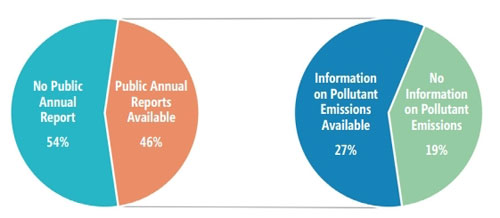
5. From Local Pollutant Disclosure to Carbon Emissions Information Disclosure
In recent years, the disclosure of carbon emissions data has also begun. The latest “Interim Measures for the Administration of Carbon Emission Permit Trading (Draft for Soliciting Opinions)” released this year has not yet included the emission data and quota allocation of key emission entities into the scope of information disclosure. Although the “13th Five-Year Plan” for controlling greenhouse gas emissions (before 2020) has yet to achieve the goal of "establishing a company's greenhouse gas emissions disclosure system", it has been observed that since 2018, Shaanxi Province has taken the lead in requiring enterprises to disclosure carbon emissions information 23. Sichuan and Jiangxi provinces have also put forward clear requirements for corporate carbon disclosure. The IPE Climate Change Database currently includes greenhouse gas emissions data from nearly 200 companies, including companies with an annual GHG emissions of more than one million tons from the power, petrochemical, chemical, steel, and cement industry.
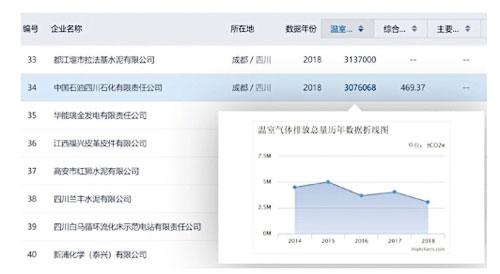
6. From Stationary Sources to Mobile Sources
The Ministry of Ecology and Environment recently released the "China Mobile Sources Environmental Management Annual Report (2019)". The report shows that pollution from mobile sources such as motor vehicles has become an important source of air pollution in China. In addition, the contribution of non-road mobile sources such as engineering machinery, agricultural machinery, ships, aircraft, and railway locomotives to air quality cannot be ignored.24 The importance of mobile source pollution prevention and the need for information disclosure, such as supervision, are increasingly prominent.
In November 2018, 11 ministries, including the Ministry of Ecology and Environment, the National Development and Reform Commission, the Ministry of Industry and Information Technology, the Ministry of Public Security, and the Ministry of Transport, jointly released the “Action Plan to Fight Against Diesel Trucks Pollution,” and proposed to achieve the goal of “significantly improving the ability and level of motor vehicle emissions supervision... a green, low-carbon, clean and efficient transportation system has begun to take shape”. The action plan will build and improve the integrated vehicle emission monitoring system, and promote the construction of road remote sensing monitoring of motor vehicles and remote online monitoring systems for heavyduty diesel vehicles.
According to our observations, environmental agencies and maritime departments in some regions have started to disclose information about environmental violations such as motor vehicles and ships to the public. In June of this year, the Beijing Municipal Bureau of Ecology and Environment issued a 170 million yuan fine25 for Anhui Jianghuai Automobile Group Co., Ltd. for “improperly replacing qualified emission inspection products with inferior and ill-equipped pollution control equipment.” In addition, some regions have also released remote sensing monitoring data for motor vehicles to the public.
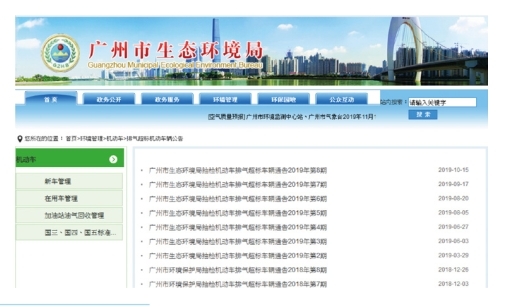
Annex : Assessment Results
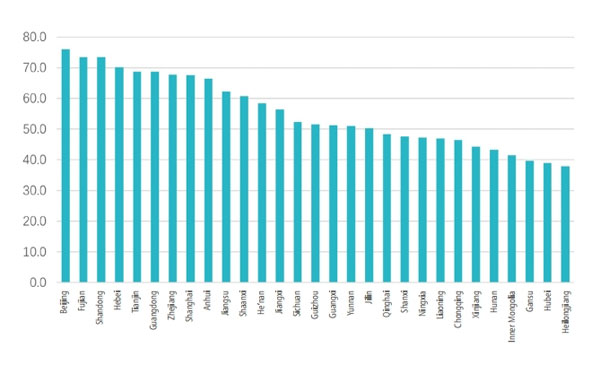

Notes :
- Green Stone Environmental Protection Center (Nanjing), Green Hunan and Green Hebei, and Nanjing University have also participated
in PITI evaluation work. - The data on the cleanup of environmental protection violations projects released in 2016 in a centralized manner was not included in
the statistics. - Estimated Pollution Source Supervision Information is calculated based on the amount of industrial pollutant emissions in each city
and the level of information disclosure of leading cities - “Regulations on the Establishment of Shandong Key Polluting Entities List and the Management of the Pollution Sources Automatic
Monitoring Network” (LU Environment [2019] No. 134), the Shandong Provincial Department of Ecology and Environment, 2019/9/9,
http://xxgk--sdein--gov--cn---z59ccwww--hunan--gov--cn.ipv6.hunan.gov.cn/zfwj/lhf/201909/t20190917_2375139.html - How do environmental protection organizations "assist" in environmental governance? GUO Xueping, China Environment Network,
http://www.zhhjw.org/a/qkzz/zzml/201910/gy/2019/1028/7291.html?from=timeline&isappinstalled=0 - Information provided by Lvse Jiangnan
- The number of cities carrying out PM2.5 monitoring varies in different years, 74 cities in 2013, 161 cities in 2014, and 338 cities in
2015, 2016, 2017 and 2018 - Among the 11 cities in the Fenwei Plain, 8 cities including Linfen, Luoyang, Sanmenxia, Xi'an, Tongchuan, Baoji, Xianyang, and Weinan
are in the scope of PITI evaluation. - The annual average of PM 2.5 in Hebei and Shandong comes from the annual environmental state bulletins of each province. The
average annual PM2.5 value of the Fenwei Plain is calculated from real-time monitoring data of urban air quality obtained from the
Blue Map . The data has not been reviewed for validity and is for reference only, please refer to official statistics. - The comparison results are only comparing observation data, and the correlation analysis needs further academic research.
- Law Enforcement Bureau of the Ministry of Ecology and Environment respond to reporters' questions on environmental administrative
law enforcement punishment, MEE, 2019/12/25, http://www.mee.gov.cn/xxgk/hjyw/201912/t20191225_753424.shtml - The data for 2014 and 2018 comes from "The fourth press conference of protecting the green water and the green mountains and
casting the golden mountains and the silver mountains to celebrate the 70th anniversary of the founding of New China", http://
www.mee.gov.cn/xxgk/hjyw/201909/t20190930_736364.
The data for 2015, 2016 and 2017 comes from "The Ministry of Ecology and Environment Held National Environmental Law
Enforcement Work Conference " - Ma, L., & Yu, W. (2018). Subjective and objective air quality in urban China: The moderating effect of environmental transparency.
China Policy Journal, 1(1), 85-109. - Beautiful China Pioneer List (2) | Jiangsu Changzhou Waste-to-energy Project Innovative Practices: From "Employee Only" to "Urban
Living Room", Ministry of Ecology and Environment’s Website, 2019-08-14 - Tighter supervision promotes transformation of domestic waste incineration power generation industry, China Environment News,2019/12/24, https://www.cenews.com.cn/news/201912/t20191224_923202.html
- Causes and Countermeasures of Local Government Environmental Management Failure, LIU Yao, Modern Economic Research,
Volume 10 (2018) - The action calls on real estate companies to jointly establish a classified procurement plan from the “environmental impact”
dimension, manage the supply chain from raw material mining, production processes to end-consumption, improve environmental
efficiency and resource utilization efficiency, and take responsibility for social development and environmental protection. - How are listed companies' environmental information disclosed? China Environment News, 2018-07-25
- CHEN Yulu, Deputy Governor of PBOC: China will study the mandatory environmental information disclosure of various market
entities, JIANG Fan from CLS, https://www.jiemian.com/article/2605194.html - Management Incineration Power Plant Enters a New Stage¬ -- “Administrative Regulations on the Application of Automatic
Monitoring Data for Domestic Waste Incineration Power Plants” Explained, MEE, 2019/12/02, http://www.mee.gov.cn/xxgk2018/
xxgk/xxgk15/201912/t20191202_744963.html - Retrospect and Prospect of China's Ecological Environment Monitoring Reform in the Past 40 Years, CHEN Shanrong, Environmental
Protection, 2018, 46(20). - 2016-2017 PITI Report, http://wwwoa.ipe.org.cn//Upload/201711210239414636.pdf
- Notice of Shaanxi Provincial Development and Reform Commission on Carrying Out the Disclosure of Greenhouse Gas Emissions
of Key Enterprises (Shannxi DRC Climate [2018] No. 132), Shaanxi Provincial Development and Reform Commission, http://sndrc.
shaanxi.gov.cn/html/100345/1027911.html - “China Mobile Sources Environmental Management Annual Report (2019),” Ministry of Ecology and Environment, 2019-09-04,
http://www.mee.gov.cn/xxgk2018/xxgk/xxgk15/201909/t20190904_732374.html - Beijing Eco Auto Fine [2018] No. 19, Beijing Ecological Environment Bureau, 2019-06-28, http://services.bjepb.gov.cn/eportal/ui?pageId=132318#

